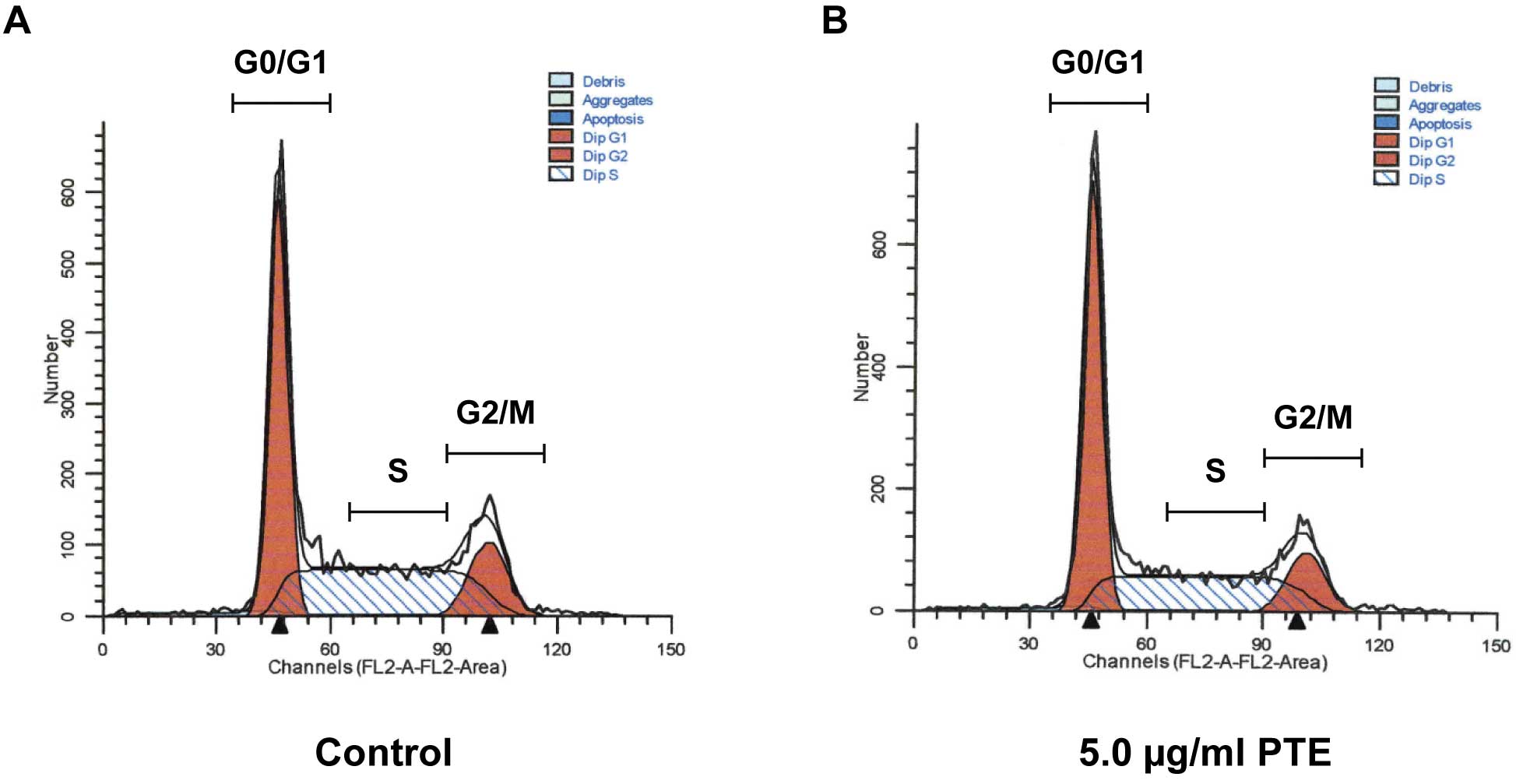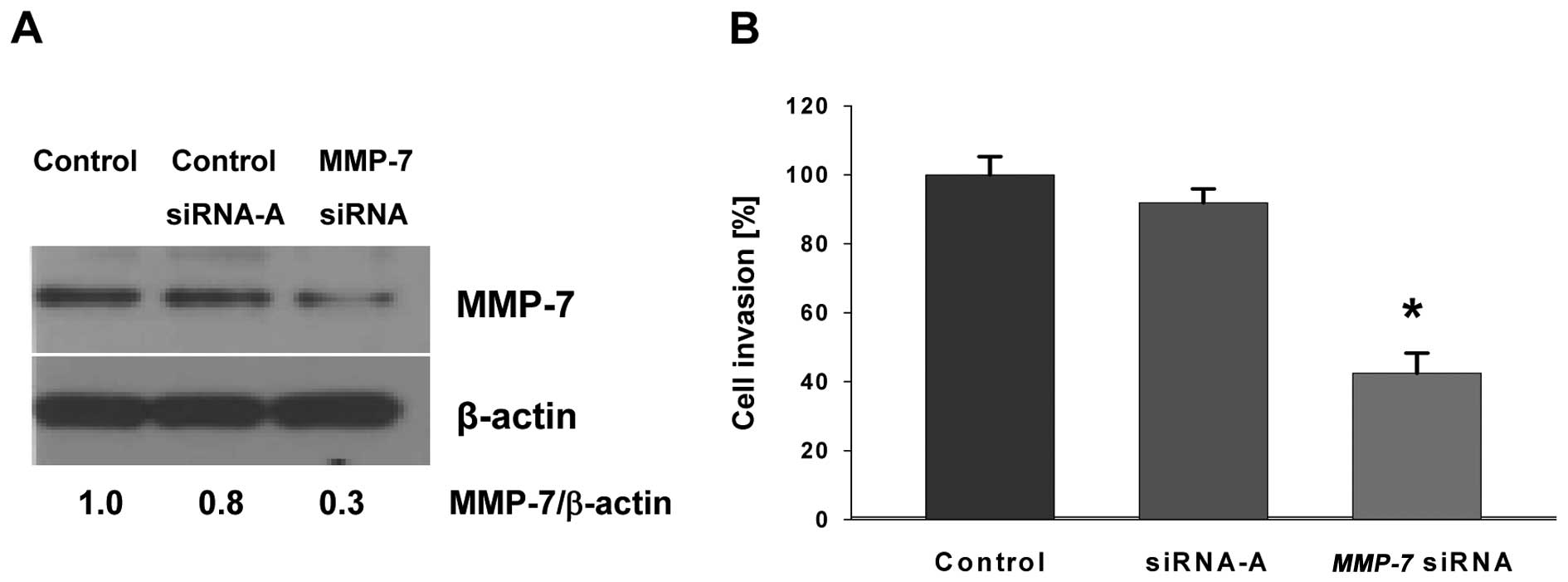|
1
|
Siegel R, Naishadham D and Jemal A: Cancer
statistics, 2012. CA Cancer J Clin. 62:10–29. 2012. View Article : Google Scholar
|
|
2
|
Rhee YH, Jeong SJ, Lee HJ, et al:
Inhibition of STAT3 signaling and induction of SHP1 mediate
antiangiogenic and antitumor activities of ergosterol peroxide in
U266 multiple myeloma cells. BMC Cancer. 12:282012. View Article : Google Scholar : PubMed/NCBI
|
|
3
|
Lee CC, Yang HL, Way TD, et al: Inhibition
of cell growth and induction of apoptosis by Antrodia
camphorata in HER-2/neuoverexpressing breast cancer cells
through the induction of ROS, depletion of HER-2/neu and disruption
of the PI3K/Akt signaling pathway. Evid Based Complement Alternat
Med. 2012:7028572012.PubMed/NCBI
|
|
4
|
Kuo YC, Lai CS, Tsai CY, Nagabhushanam K,
Ho CT and Pan MH: Inotilone suppresses phorbol ester-induced
inflammation and tumor promotion in mouse skin. Mol Nutr Food Res.
56:1324–1332. 2012. View Article : Google Scholar : PubMed/NCBI
|
|
5
|
Torkelson CJ, Sweet E, Martzen MR, et al:
Phase 1 clinical trial of Trametes versicolor in women with
breast cancer. ISRN Oncol. 2012:2516322012.PubMed/NCBI
|
|
6
|
Rios JL: Chemical constituents and
pharmacological properties of Poria cocos. Planta Med.
77:681–691. 2011. View Article : Google Scholar : PubMed/NCBI
|
|
7
|
Lee SM, Lee YJ, Yoon JJ, Kang DG and Lee
HS: Effect of Poria cocos on hypertonic stress-induced water
channel expression and apoptosis in renal collecting duct cells. J
Ethnopharmacol. 141:368–376. 2012.
|
|
8
|
Zhao YY, Feng YL, Du X, Xi ZH, Cheng XL
and Wei F: Diuretic activity of the ethanol and aqueous extracts of
the surface layer of Poria cocos in rat. J Ethnopharmacol.
144:775–778. 2012. View Article : Google Scholar : PubMed/NCBI
|
|
9
|
Chen X, Zhang L and Cheung PC:
Immunopotentiation and anti-tumor activity of
carboxymethylated-sulfated beta-(1→3)-d-glucan from Poria
cocos. Int Immunopharmacol. 10:398–405. 2010.PubMed/NCBI
|
|
10
|
Kikuchi T, Uchiyama E, Ukiya M, et al:
Cytotoxic and apoptosis-inducing activities of triterpene acids
from Poria cocos. J Nat Prod. 74:137–144. 2011. View Article : Google Scholar : PubMed/NCBI
|
|
11
|
Ling H, Zhou L, Jia X, Gapter LA, Agarwal
R and Ng KY: Polyporenic acid C induces caspase-8-mediated
apoptosis in human lung cancer A549 cells. Mol Carcinog.
48:498–507. 2009. View
Article : Google Scholar : PubMed/NCBI
|
|
12
|
Ling H, Zhang Y, Ng KY and Chew EH:
Pachymic acid impairs breast cancer cell invasion by suppressing
nuclear factor-kappaB-dependent matrix metalloproteinase-9
expression. Breast Cancer Res Treat. 126:609–620. 2011. View Article : Google Scholar : PubMed/NCBI
|
|
13
|
Zhou L, Zhang Y, Gapter LA, Ling H,
Agarwal R and Ng KY: Cytotoxic and anti-oxidant activities of
lanostane-type triterpenes isolated from Poria cocos. Chem
Pharm Bull. 56:1459–1462. 2008. View Article : Google Scholar : PubMed/NCBI
|
|
14
|
Mizushina Y, Akihisa T, Ukiya M, et al: A
novel DNA topoisomerase inhibitor: dehydroebriconic acid, one of
the lanostane-type triterpene acids from Poria cocos. Cancer
Sci. 95:354–360. 2004. View Article : Google Scholar : PubMed/NCBI
|
|
15
|
Hong R, Shen MH, Xie XH and Ruan SM:
Inhibition of breast cancer metastasis via PITPNM3 by pachymic
acid. Asian Pac J Cancer Prev. 13:1877–1880. 2012. View Article : Google Scholar : PubMed/NCBI
|
|
16
|
Ling H, Jia X, Zhang Y, et al: Pachymic
acid inhibits cell growth and modulates arachidonic acid metabolism
in nonsmall cell lung cancer A549 cells. Mol Carcinog. 49:271–282.
2010.PubMed/NCBI
|
|
17
|
Jiang J, Slivova V, Harvey K,
Valachovicova T and Sliva D: Ganoderma lucidum suppresses growth of
breast cancer cells through the inhibition of Akt/NF-kappaB
signaling. Nutr Cancer. 49:209–216. 2004. View Article : Google Scholar : PubMed/NCBI
|
|
18
|
Sliva D, Jedinak A, Kawasaki J, Harvey K
and Slivova V: Phellinus linteus suppresses growth, angiogenesis
and invasive behaviour of breast cancer cells through the
inhibition of AKT signalling. Br J Cancer. 98:1348–1356. 2008.
View Article : Google Scholar : PubMed/NCBI
|
|
19
|
Sliva D, Harvey K, Mason R, Lloyd F Jr and
English D: Effect of phosphatidic acid on human breast cancer cells
exposed to doxorubicin. Cancer Invest. 19:783–790. 2001. View Article : Google Scholar : PubMed/NCBI
|
|
20
|
Lloyd FP Jr, Slivova V, Valachovicova T
and Sliva D: Aspirin inhibits highly invasive prostate cancer
cells. Int J Oncol. 23:1277–1283. 2003.PubMed/NCBI
|
|
21
|
Livak KJ and Schmittgen TD: Analysis of
relative gene expression data using real-time quantitative PCR and
the 2(-Delta Delta C(T)) method. Methods. 25:402–408. 2001.
View Article : Google Scholar : PubMed/NCBI
|
|
22
|
Gapter L, Wang Z, Glinski J and Ng KY:
Induction of apoptosis in prostate cancer cells by pachymic acid
from Poria cocos. Biochem Biophys Res Commun. 332:1153–1161.
2005. View Article : Google Scholar : PubMed/NCBI
|
|
23
|
Bournet B, Pointreau A, Souque A, et al:
Gene expression signature of advanced pancreatic ductal
adenocarcinoma using low density array on endoscopic
ultrasound-guided fine needle aspiration samples. Pancreatology.
12:27–34. 2012. View Article : Google Scholar
|
|
24
|
Nagaraj NS, Washington MK and Merchant NB:
Combined blockade of Src kinase and epidermal growth factor
receptor with gemcitabine overcomes STAT3-mediated resistance of
inhibition of pancreatic tumor growth. Clin Cancer Res. 17:483–493.
2011. View Article : Google Scholar : PubMed/NCBI
|
|
25
|
Hlavaty J, Petznek H, Holzmuller H, et al:
Evaluation of a gene-directed enzyme-product therapy (GDEPT) in
human pancreatic tumor cells and their use as in vivo models for
pancreatic cancer. PLoS One. 7:e406112012. View Article : Google Scholar : PubMed/NCBI
|
|
26
|
Tascilar M, Skinner HG, Rosty C, et al:
The SMAD4 protein and prognosis of pancreatic ductal
adenocarcinoma. Clin Cancer Res. 7:4115–4121. 2001.
|
|
27
|
Singh P, Srinivasan R and Wig JD: SMAD4
genetic alterations predict a worse prognosis in patients with
pancreatic ductal adenocarcinoma. Pancreas. 41:541–546. 2012.
View Article : Google Scholar : PubMed/NCBI
|
|
28
|
Crawford HC, Scoggins CR, Washington MK,
Matrisian LM and Leach SD: Matrix metalloproteinase-7 is expressed
by pancreatic cancer precursors and regulates acinar-to-ductal
metaplasia in exocrine pancreas. J Clin Invest. 109:1437–1444.
2002. View Article : Google Scholar : PubMed/NCBI
|
|
29
|
Fukushima H, Yamamoto H, Itoh F, et al:
Association of matrilysin mRNA expression with K-ras mutations and
progression in pancreatic ductal adenocarcinomas. Carcinogenesis.
22:1049–1052. 2001. View Article : Google Scholar : PubMed/NCBI
|
|
30
|
Jones LE: Comprehensive analysis of matrix
metalloproteinase and tissue inhibitor expression in pancreatic
cancer: increased expression of matrix metalloproteinase-7 predicts
poor survival. Clin Cancer Res. 10:2832–2845. 2004. View Article : Google Scholar
|
|
31
|
Fukuda A, Wang SC, Morris JP IV, et al:
Stat3 and MMP7 contribute to pancreatic ductal adenocarcinoma
initiation and progression. Cancer Cell. 19:441–455. 2011.
View Article : Google Scholar : PubMed/NCBI
|
|
32
|
Ling Y, Chen M, Wang K, et al: Systematic
screening and characterization of the major bioactive components of
Poria cocos and their metabolites in rats by LC-ESI-MS(n).
Biomed Chromatogr. 26:1109–1117. 2012.PubMed/NCBI
|
















